I've listened to the Triode Lab 45 EVO single-ended-triode (SET) integrated amplifier in three different audio system contexts now.
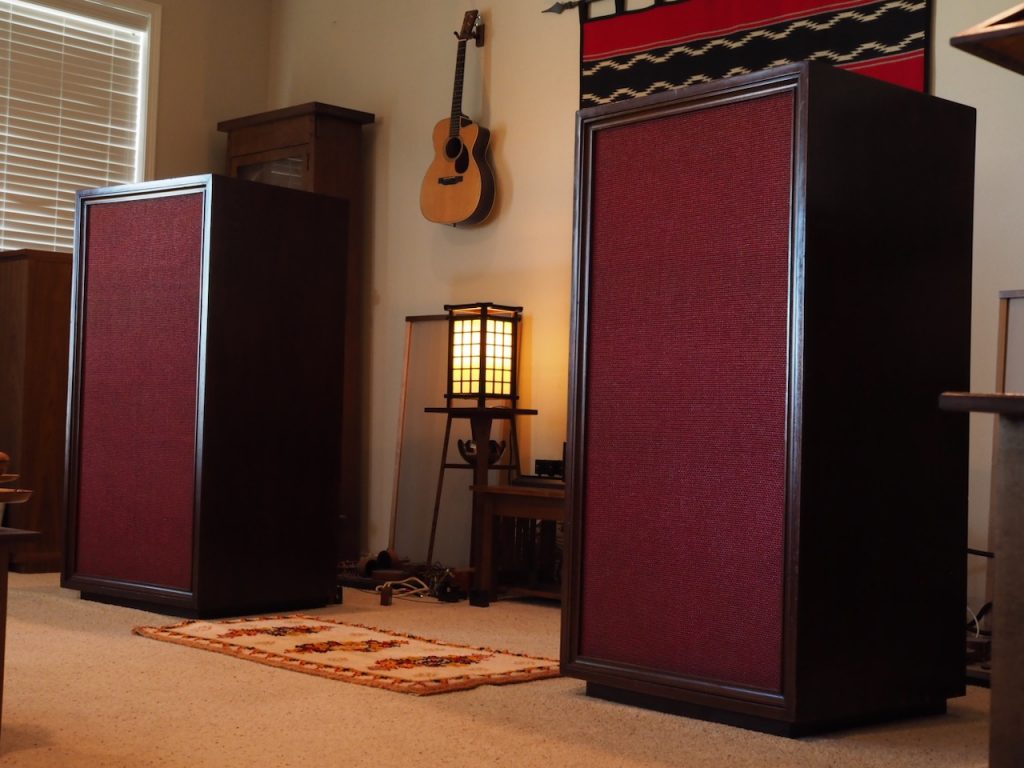
Custom vintage Altec loudspeakers built for conductor Leopold Stokowski.
First with my Duelund-ized vintage "Stokowski" Altec loudspeakers (HERE) in my main music system (above), where the Triode Lab 45 EVO SET integrated amplifier provided those classic goosebumps musical experiences that the combination of highly-sensitive loudspeakers and single-ended-triode amplification seem to so easily achieve.
Then with my vintage Altec A5 Voice of the Theatre loudspeakers in my audio-visual system (below), I again experienced that combination of highly-sensitive loudspeakers and the Triode Lab 45 EVO single-ended-triode amplification that made watching movies or television shows an exciting, engrossing, and immersive experience.
There's something really special about that kind of video experience, and it hearkened me back to the days of my youth, when the small-town American movie theaters still used Altec A5 loudspeakers with Western Electric 91-A amplifiers.
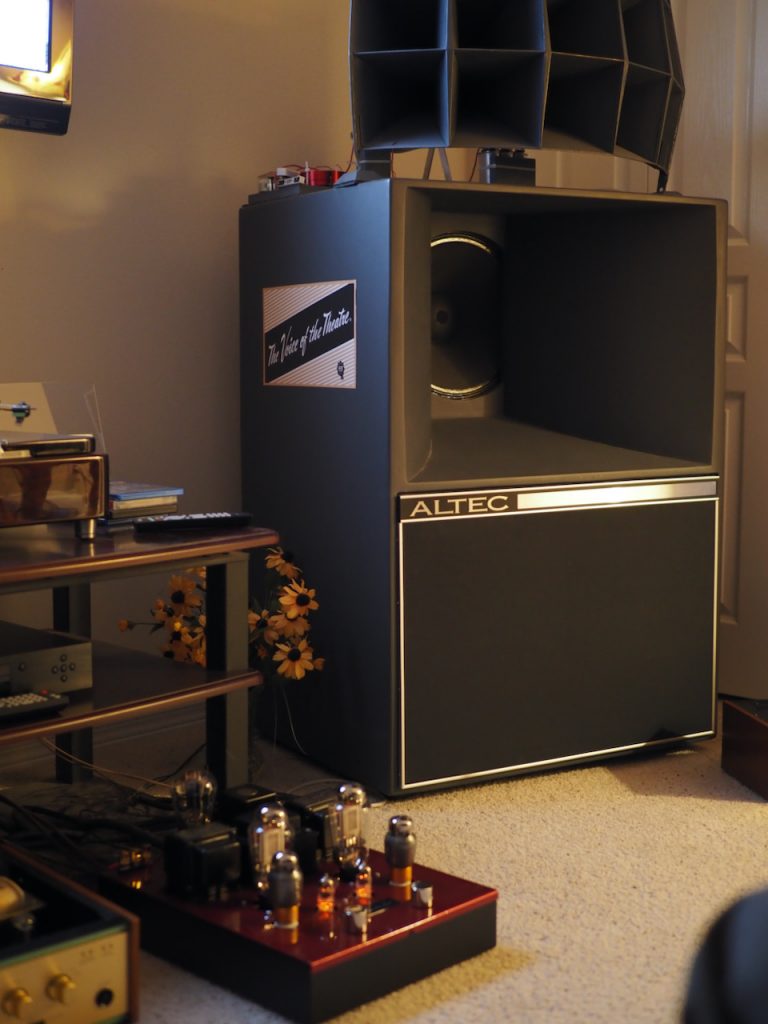
Triode Lab 45 EVO SET integrated amplifier with Altec A5 Voice of the Theatre loudspeakers.
Now I'm listening to the Triode Lab 45 EVO SET integrated amplifier in my main music system with my Duelund-ized Tannoy Westminster Royal SE loudspeakers (below).
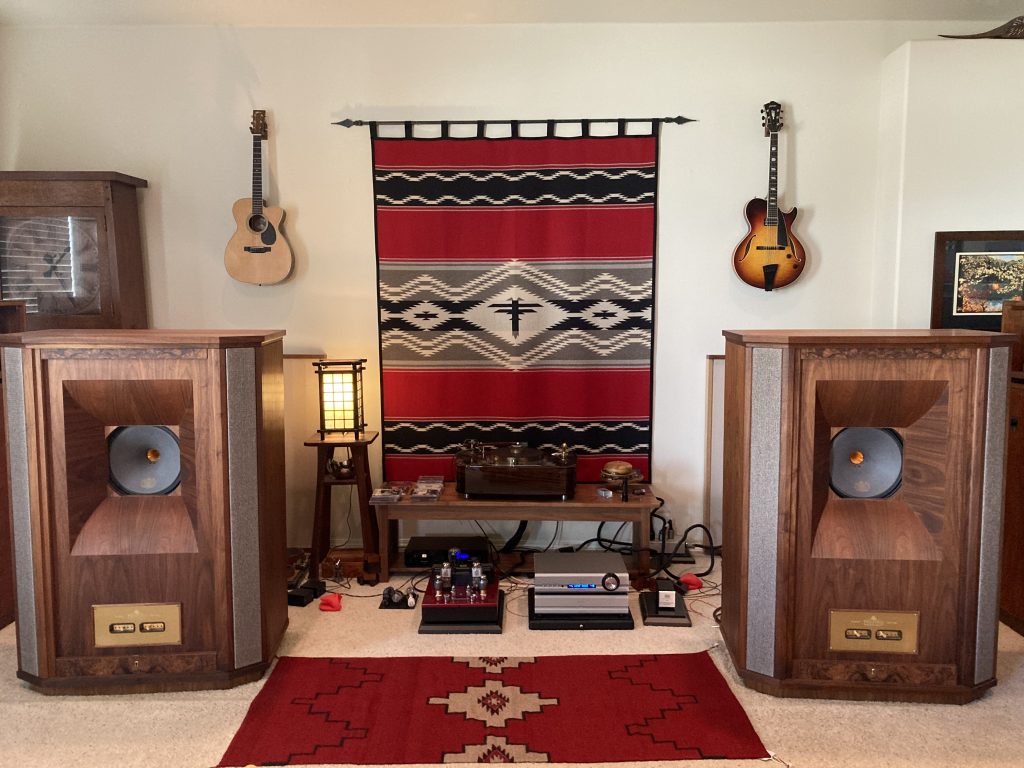
Triode Lab 45 EVO SET integrated amplifier with Tannoy Westminster Royal SE loudspeakers.
I find it really valuable to listen to audio components in a number of different contexts, as it gives me a better idea of their overall performance.
Vintage Altecs are highly sensitive loudspeakers. Altec's published specifications stated their A7 and A5 Voice of the Theatre loudspeakers as having 97dB sensitivity.
However, you see different sensitivity ratings for vintage Altecs from different sources, like for example, when Altec A7s were measured at 109.2dB sensitivity by Sound Practices magazine (HERE).
From my own experiences, I would say that Sound Practices' sensitivity rating seems to reflect the reality I hear from my vintage Altecs better than does Altec's own published specifications, but that's a subjective statement, as I haven't measured their sensitivity myself.
My Tannoy Westminster loudspeakers have a published sensitivity of 99 dB (2.83 V @ 1 m). One would think that low-powered amplifiers like the Triode Lab would be a great match for the Westminsters, but in the past I haven't had much luck with low-powered amplifiers driving my Westminsters. I had considered 30 watts as the lower limit for reliably getting live-like SPLs from the albums I was listening to.
My perspective on the Westminsters' performance with low-powered amplifiers has changed recently. That's primarily due to the ability of the 2-watt Triode Lab 45 EVO SET integrated amplifier to drive the West's to live-like listening levels with the program material I've been listening to.
My most frequent music listening friend of late has been jazz guitarist David Gitlen. David stops by once a week to teach me a jazz guitar lesson, and then afterwards we listen to a jazz guitar CD that David has brought along to demonstrate certain jazz guitar techniques he's teaching me about, while we sip a little espresso, and enjoy the music.
It has been an awesome experience taking jazz guitar lessons from David. David's played and studied jazz guitar with a lot of jazz luminaries, two of which happen to be Jim Hall and Joe Pass, so David has lots of insights into what they're doing with their techniques, which provides lots of illumination for me as a student learning to play jazz guitar. Plus, it is just a lot of fun, and my jazz guitar CD collection is growing nicely!
The Triode Lab 45 EVO SET has been David's favorite vacuum tube amplifier on my Tannoy Westminster Royal SE loudspeakers so far.
Musicians tend to listen a little different than a typical casual listener, as they're often listening to learn what the musician on a recording is doing with their instrument, and how they are doing it, so that they can play what they are hearing themselves.
In my case, David is trying to teach me how to learn to do that, so I can listen to what is being played, figure out the key, and then learn how to play along with the album. It's a great way to learn that I'm just getting started with.
In the old days guitarists would put on an LP, figure out the key the music was in, and then would listen to a particular performance over and over again, until they knew the exact position of the notes and chords that were being played on the fretboard.
Joe Pass talks about how he did this with his LPs on the instructional DVD "An Evening With Joe Pass" that was filmed at the Musicians Institute, when he visited there to meet with students and perform a concert.
CD players were a boon to musicians because it made this process much easier, as you could just put a section of music on "repeat" and listen to it until you figured it out.
Transparency and resolution make figuring out the key, chords, and notes being used in a song on an album a lot easier because it makes everything easier to identify.
Also, if the music is tonally and timbrally correct that helps a lot too.
That's where the Triode Lab 45 EVO really comes into its own, as it is very transparent and resolving, but at the same time it sounds very musically natural and life-like, so its great for getting insights into what the musicians are doing as they are playing music.
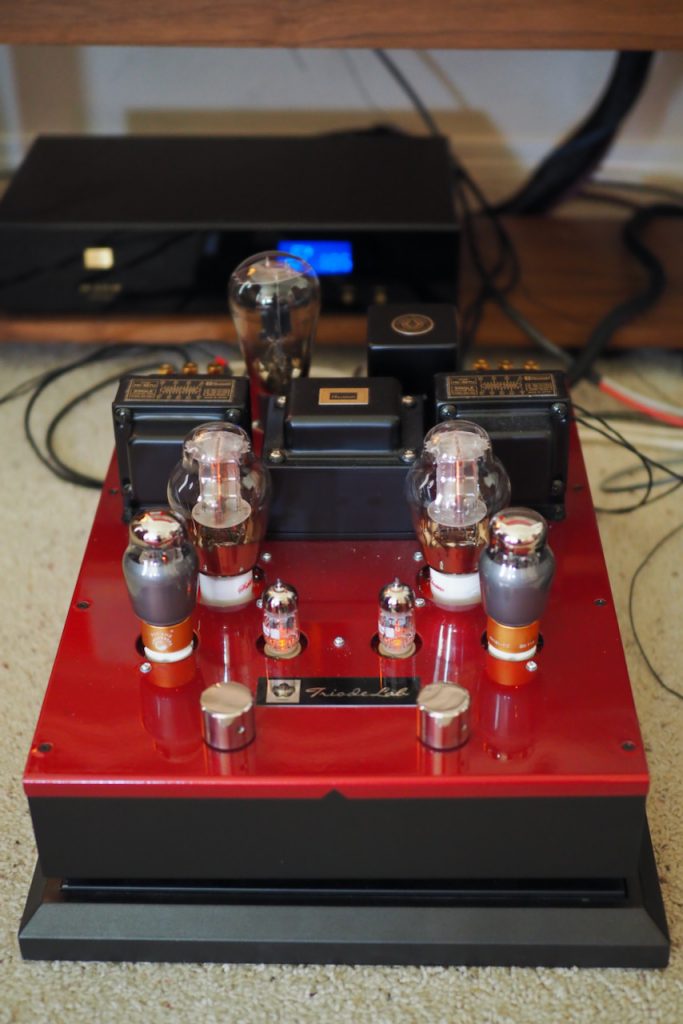
Triode Lab 45 EVO SET integrated amplifier.
With those qualities, the 45 EVO might be one of the ultimate SET tube amps for musicians. When combined with a really good CD player like the Audio Note (UK) CD 2.1x/II Level Two CD player, and the revealing and musical Tannoy Westminster Royal SE loudspeakers, its a simple ultra-performing audio system that any musician would be delighted to come home to. Or anyone else for that matter.
As a high-performance SET amplifier, the Triode Lab 45 EVO makes it easy to hear the difference between vacuum tubes, and in fact it is very sensitive to vacuum tubes when you are trying to achieve a voicing that suits one's associated equipment and personal tastes.
I'll have a lot more to tell you about the Triode Lab 45 EVO SET integrated amplifier in its upcoming feature article for Positive Feedback, but today let's just talk about vacuum tubes.
In particular, the Sophia Electric 45 mesh plates, the Emission Labs 45 mesh plates, the Sophia Electric Aqua 274B rectifier, and the Psvane Acme 274B rectifier.
Vacuum Tubes
Vacuum tubes do something that even the very best sounding solid-state amplification devices - as really good as they are these days - can't do. Koselig.
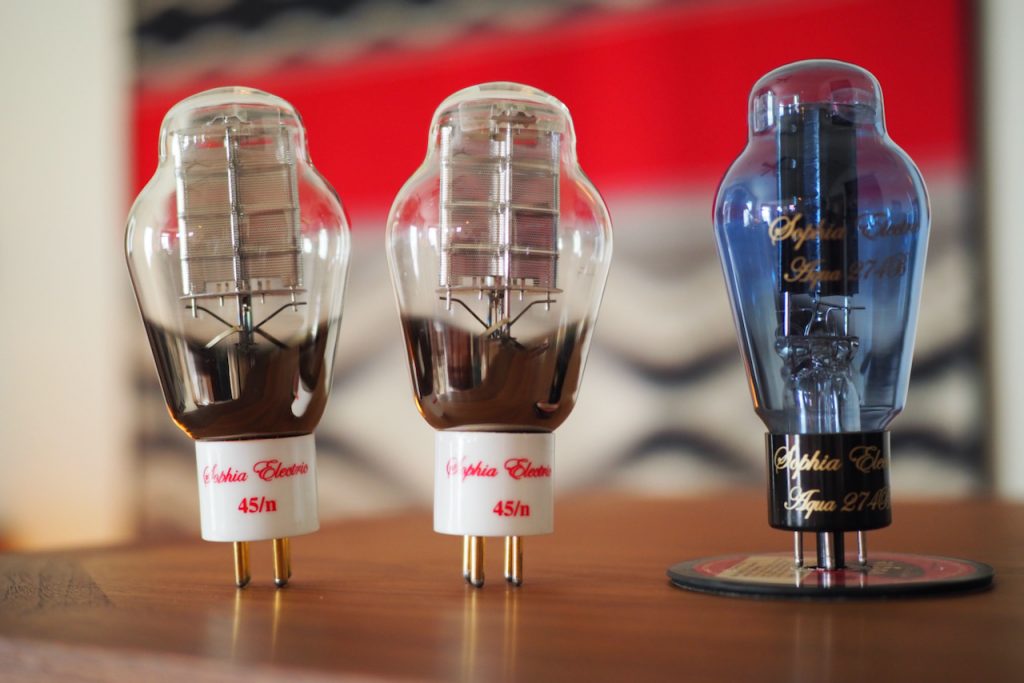
Sophia Electric 45 Mesh Plates and Sophia Electric Aqua 274B Rectifier.
My genetic roots - in part - go back to Lillehammer, Norway. In Norway the term koselig is used to describe a feeling of coziness, wellness, and contentment. Happiness.
In Denmark that feeling is called hygge. In the Netherlands that feeling is called gezelligheid.
According to the Happiness Research Institute in Copenhagen, koselig, hygge, and gezelligheid, are an important practice in making those countries consistently among the top rated countries on Planet Earth for happiness.

Koselig is a way of living that enhances happiness. Meik Wiking, in his The Little Book of Hygge described koselig thusly:
"More than anything, koselig is a feeling of warmth, intimacy, and getting together. A perfect koselig evening would consist of good food on the table, warm colors around you, a group of good friends, and a fireplace, or at least some lighted candles."
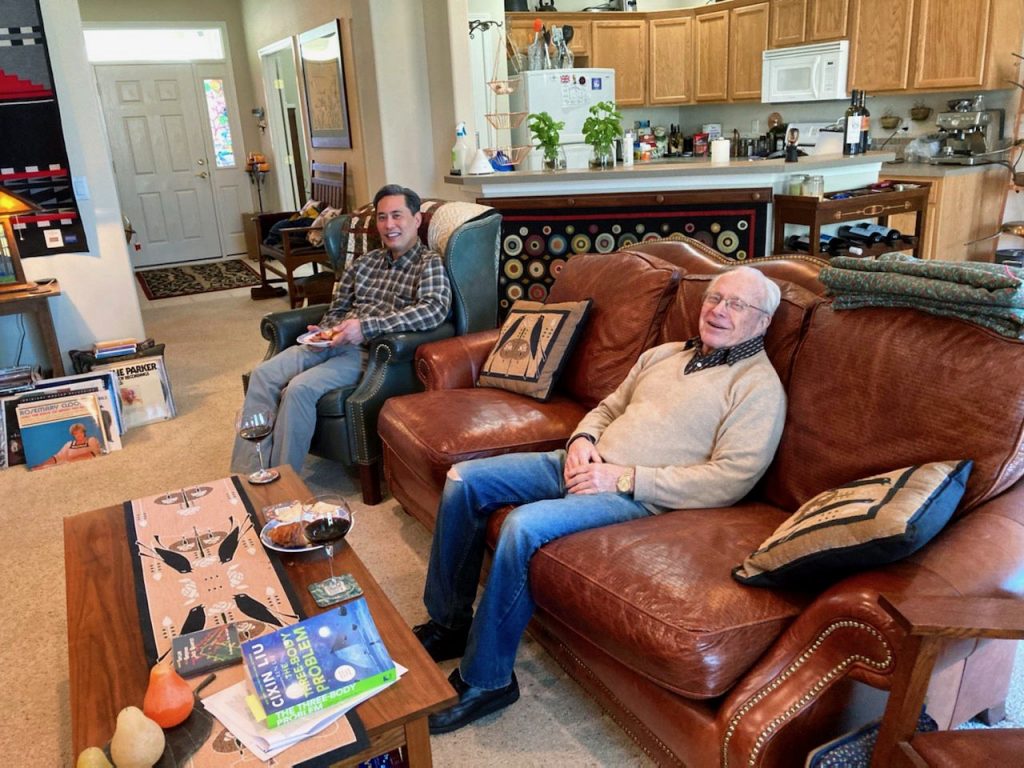
Doc Leo (left), Ron Barbee (right).
For example, a few weekends ago I had my friends Ron Barbee and Doc Leo over for a visit. It was our first visit together since the coronavirus pandemic started. I had good food on the table, we had nice wine selections, we were surrounded by warm colors, good conversation, the glow of vacuum tubes, and beautiful music. Koselig.
Lighted candles, a fire in the fireplace, and the warm glow of vacuum tubes can all contribute to that feeling of koselig.
So there you go, another benefit of vacuum tubes is that they can contribute to that feeling of koselig. Just seeing their friendly glow makes me feel happier.
Vacuum tubes have an inner fire burning. A sense of musical coziness. That feeling of koselig lent to an evening of listening to music with a fine glass of wine or a single malt in hand.

Triode Lab 45 EVO SET integrated amplifier.
With all those vacuum tubes emitting their friendly glow, the Triode Lab 45 EVO single-ended-triode integrated amplifier provides a nice dose of koselig for listening sessions. It makes me feel good just to look at it.
For this post I used the Audio Note (UK) CD 2.1x/II Level Two Red Book CD player as a source (in the background behind the 45 EVO in the photo above). No vinyl. Vinyl will be discussed in the feature article about Triode Lab 45 EVO in addition to digital.
For me the Audio Note (UK) CD 2.1x/II Level Two Red Book CD player has been a revelation, as it makes ordinary CDs sound remarkably good, and very much like real music does.
Not only am I extremely impressed with the CD 2.1x/II's musical and sound quality abilities, it has opened up a new world of music to me that really isn't available on vinyl, and it has been a tremendous resource as David and I have been exploring jazz guitar CDs.
First up, lets listen to "Lost And Found" by the Martin Eagle Quartet, featuring Martin Eagle on piano, David Gitlen on guitar, Peter Innocenti on bass, and Jeff Crouse on drums.
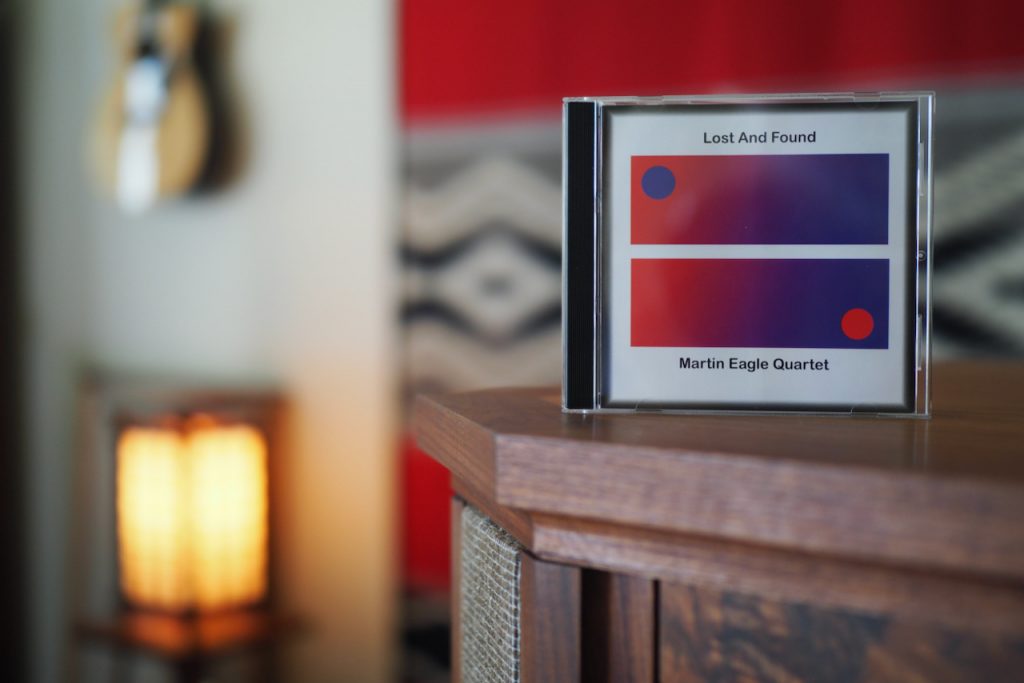
Martin Eagle Quartet, "Lost And Found".
When I first listened to this CD, based on the tonality and technique I heard, I thought it was the legendary jazz guitarist Jim Hall playing the guitar. Then I found out it was my friend and superb jazz guitarist, David Gitlen, playing on the album. Cool!
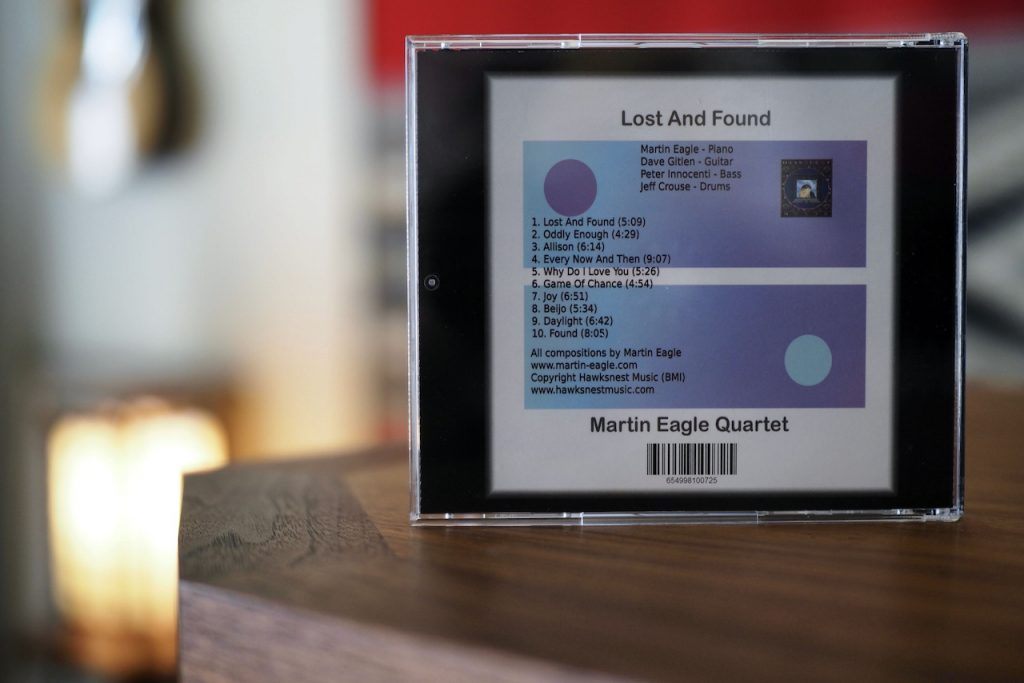
Martin Eagle Quartet, "Lost And Found".
With the Sophia Electric 45 mesh plates and the Sophia Electric Aqua 274B rectifier, that single-ended-triode (SET) goodness was in full evidence on Lost And Found through the Triode Lab 45 EVO integrated amplifier, with a natural portrayal of timbre and tone color.

Sophia Electric 45 Mesh Plates and Sophia Electric Aqua 274B Rectifier.
Due to the nature of the studio recording, "Lost And Found" is more like a classic "wide mono" jazz album than an audiophile-style recording with exaggerated visuospatial attributes. However, even though there isn't the wide soundstage that some audiophiles crave, in addition to the great music-making on the album, there was lots of resolution and vivid image presence in evidence, giving that intimate illusion that the musicians were playing in my living room.
There was no harshness, no unnatural forwardness. Just natural tonality with good foot-tapping presentations of tempo, melody, and dynamics that delivered the full emotional energy and beauty of the music during listening.
One thing I've noticed with the Triode Lab 45 EVO is that it sounds more natural, and less "hifi" lean, compared to the other 45 SET amps I've owned or written about in the past.
I really like the voicing Frank has achieved with his 45 EVO amplifier. The 45 EVO gets the music beautifully right, while still sounding superb in sonic terms on "Lost And Found".
Before Frank at Triode Labs sent me the 45 EVO, he asked me what power tubes and rectifier I preferred. It's been a while since I've listened to 45 SETs, so I asked Frankie to use the tubes he enjoyed the most in his hifi system, which were the Emission Labs 45 mesh plates and the Psvane Acme 274B rectifier.
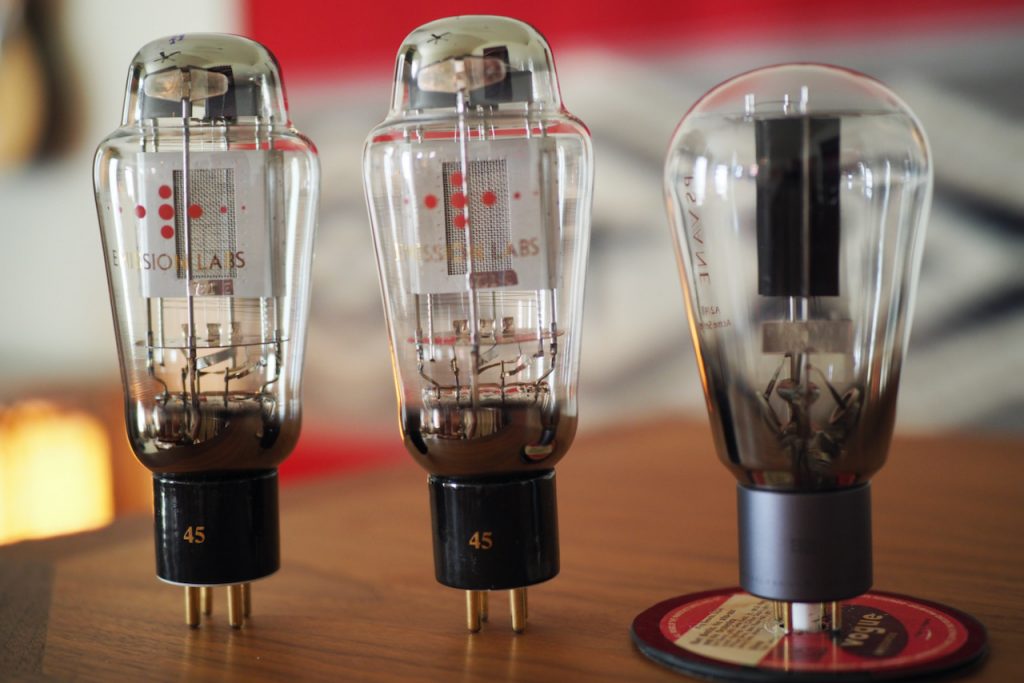
Emission Labs 45 mesh plates and the Psvane Acme 274B rectifier.
Listening to "Lost And Found" again, my impression was that the Emission Labs 45 mesh plates and the Psvane Acme 274B rectifier as a combination sounded a little darker and richer than did the Sophia Electric 45 mesh plates and the Sophia Electric Aqua 274B rectifier combination.
With the Emission Labs 45 mesh plates and the Psvane Acme 274B rectifier the images were presented as somewhat less vivid and less resolved, which combined with their darker and richer overall presentation of the music, moved the musicians from my living room to a late night jazz club, or in other words, made them seem a little more distant in the soundstage.
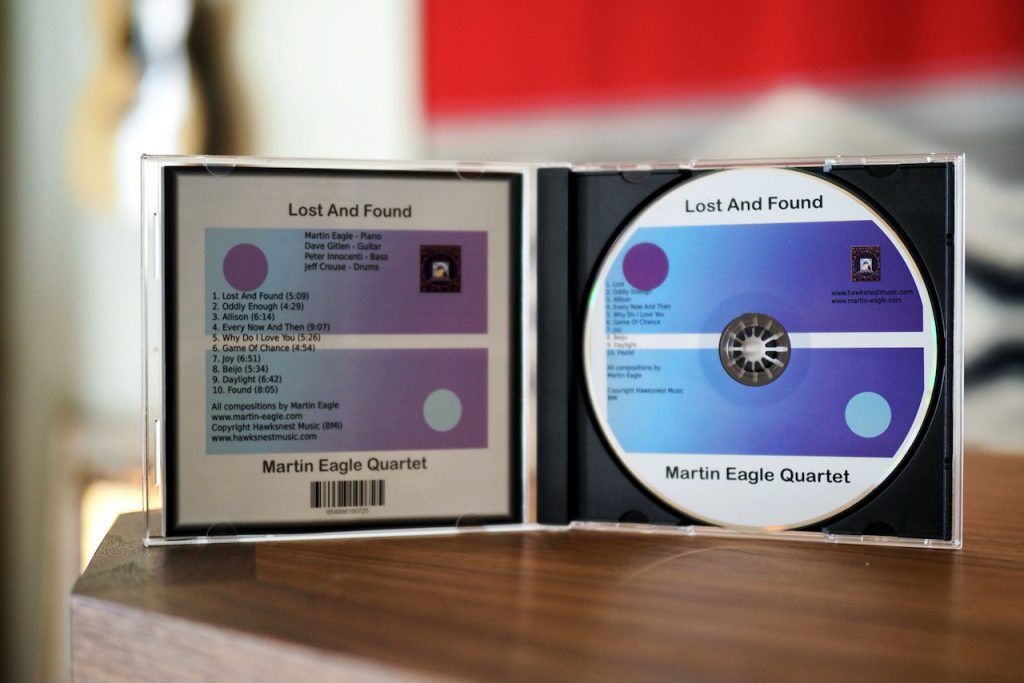
Martin Eagle Quartet, "Lost And Found".
"Lost And Found" was recorded in a studio and not in a jazz club, but that's the effect the different voicing had on the overall presentation of the music.
With the Emission Labs 45 mesh plates and the Psvane Acme 274B rectifier the music was presented as beautiful, colorful, and engaging, and with rich tonality.
On "Lost And Found" the Triode Lab 45 EVO really delivered the musical message in an enticing way, whether it was the more transparent, resolving, and vivid Sophia Electric 45 mesh plates and Sophia Electric Aqua 274B rectifier combination, or the darker, richer, more romantic sounding Emission Labs 45 mesh plates and Psvane Acme 274B rectifier combination.

The Paul Desmond Quartet's "Live" album.
The Paul Desmond Quartet's Live album, recorded live October 25 through November 1, 1975, at Bourbon Street in Toronto, features Paul Desmond on alto sax, Ed Bickert on guitar, Don Thompson on bass, and Jerry Fuller on drums.
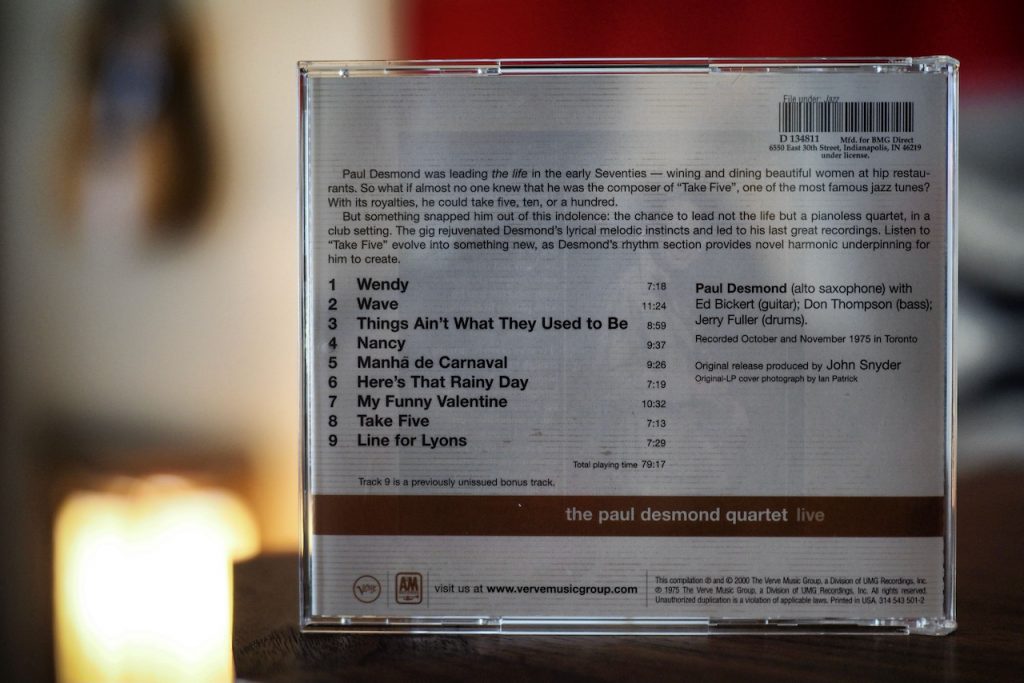
The Paul Desmond Quartet's "Live" album.
I listened to Live with the Emission Labs 45 mesh plates and the Psvane Acme 274B rectifier first, and noted its darker and less resolving presence, but I also heard a surprise I wasn't expecting, in that Paul Demond's alto sax sounded more forward and aggressive than I would have anticipated.
To be fair, an alto sax can sound a bit forward and aggressive depending on the music being played, but the presentation of the alto sax on Live was a little more unpleasant than I would have liked it to be.
Paul Desmond said he wanted his alto sax to sound like a dry martini tastes, but this was more like a straight shot of vodka. It was not what I was expecting to hear.
Next I installed the Sophia Electric 45 mesh plates and the Sophia Electric Aqua 274B rectifier combination, and listened to Live again.
I first noted the more resolving, nuanced, transparent, and articulate presentation of the music that the Sophia tube set provided.
Once again I was surprised by the alto sax, which this time was more natural, and less forward sounding with the Sophia tube set. That was sort of the opposite of what I was expecting. The alto sax could still get a little piquant with the Sophia tubes, but I thought it was more in the "dry martini" range that Paul Desmond wanted to achieve with his alto sax.
I thought with the more resolving and transparent nature of the Sophia tube set, that the alto sax would sound more forward and aggressive than it would be with the Emission Labs 45 mesh plates and the Psvane Acme 274B rectifier, but it wasn't.
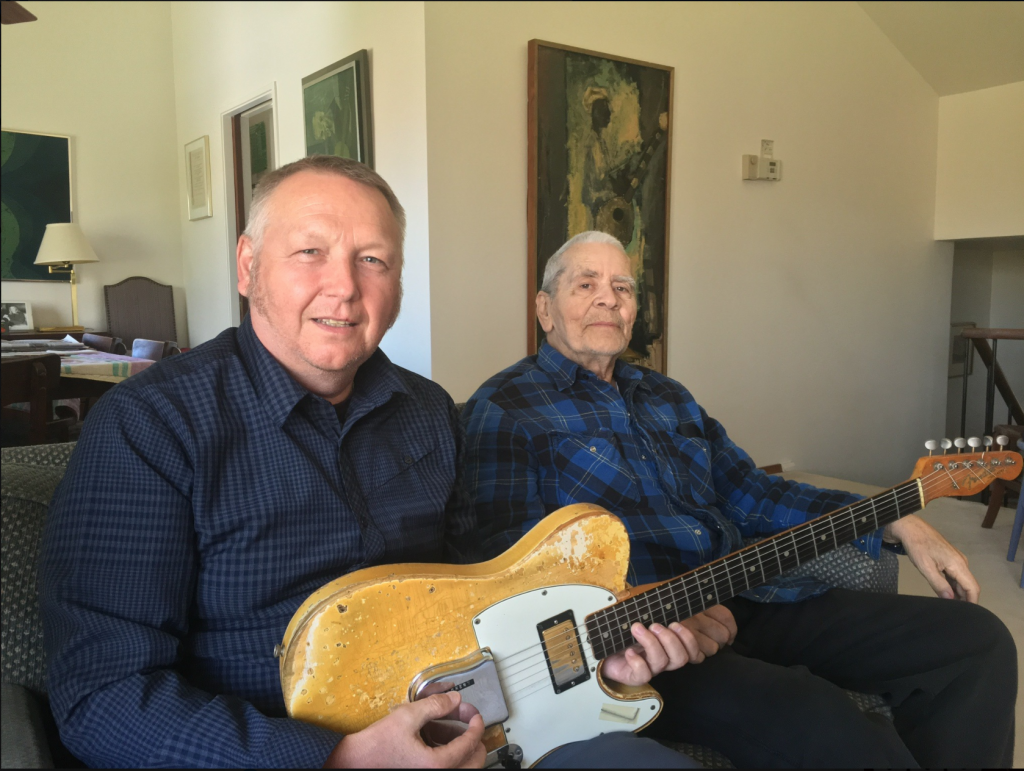
Roman Pokorny (left) with Ed Bickert (right). Roman is holding Ed's famous Telecaster. Photo provided by Roman and used with his permission.
Another thing I noticed was how I could hear more of Ed Bickert's guitar playing technique on "Here's That Rainy Day" with the Sophia tube set, making it easier to hear what Ed was doing in his playing. I also thought that Ed's guitar sounded more timbrally and tonally correct, with the Sophia tubes.
That matters to me for two reasons. First, since I have a replica of Ed's guitar that I use for my own jazz guitar studies, I recognize its basic sound qualities, and the Sophia tubes do a nice job timbrally and tonally of presenting its sound quality in realistic fashion. Second, "Here's That Rainy Day" is a song I learned to play in chord melody style, so when I listen to Ed play it, I learn more about the song and what can be done with it.
My listening prompted a question. Was it a performance trait of the Emission Labs 45 mesh plates, or of the Psvane Acme 274B rectifier, that was contributing to an aggressive tone on Desmond's alto sax?
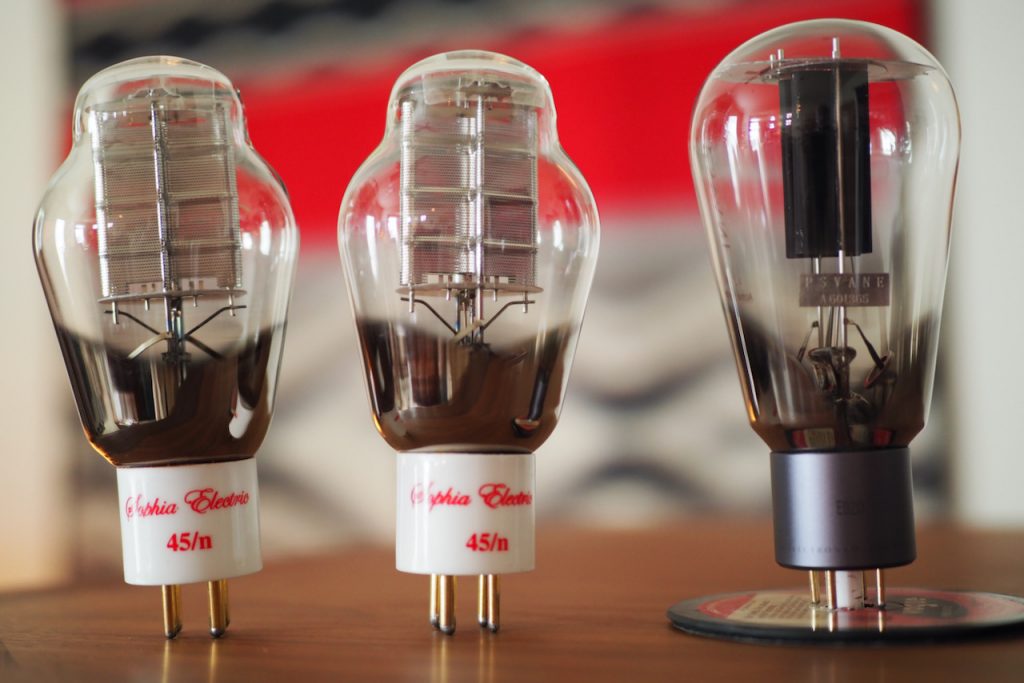
Sophia Electric 45 mesh plates and Psvane Acme 274B rectifier.
I decided to substitute the Psvane Acme 274B rectifier for the Sophia Electric Aqua 274B rectifier and give Live another listen.
While much of the transparency, resolution, and nuance of the Sophia Electric 45 mesh plates was still in evidence, the Psvane Acme 274B rectifier did make the overall presentation a little darker and richer, but also made Desmond's alto sax sound a little more forward and aggressive than the Sophia Electric Aqua 274B rectifier. I also thought Ed's guitar sounded a little more distorted with the Psvane Acme 274F rectifier as well.
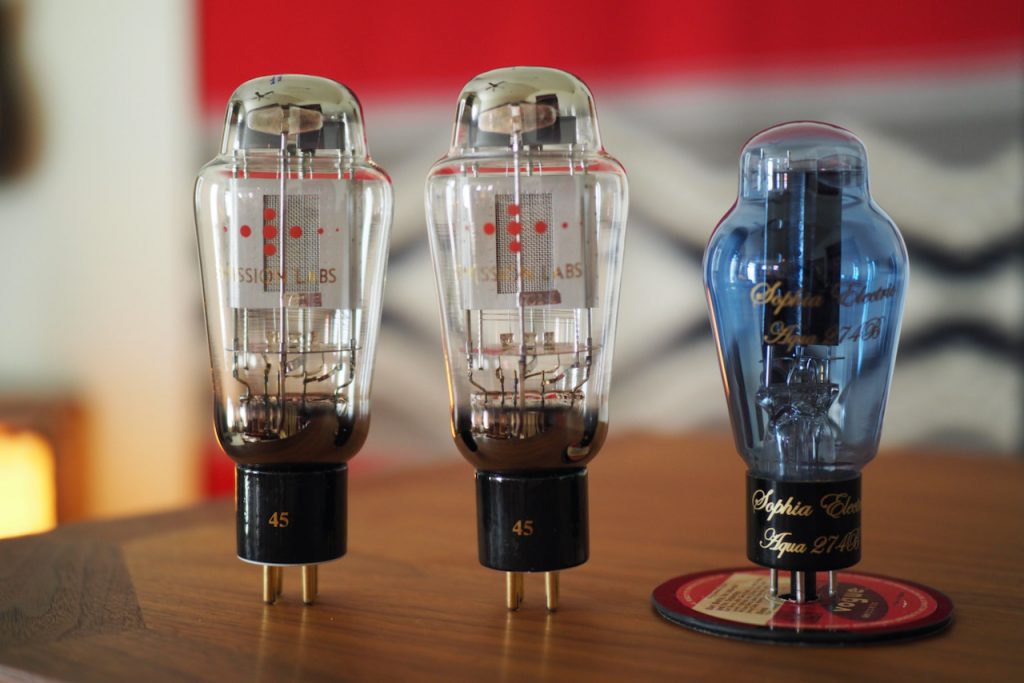
Emission Labs 45 mesh plates and Sophia Electric Aqua 274B rectifier.
The next logical thing to do was give the combination of the Emission Labs 45 mesh plates and Sophia Electric Aqua 274B rectifier a listen on Live.
The Emission Labs 45 mesh plates sound a little darker, softer, more relaxed, and less resolving than the Sophia Electric 45 mesh plates.
The Emission Labs 45 mesh plates also exhibit a similar trait to the Psvane Acme 274B rectifier, in that they highlighted the forwardness of the tone of Desmond's alto sax more than the Sophia Electric 45 mesh plates.
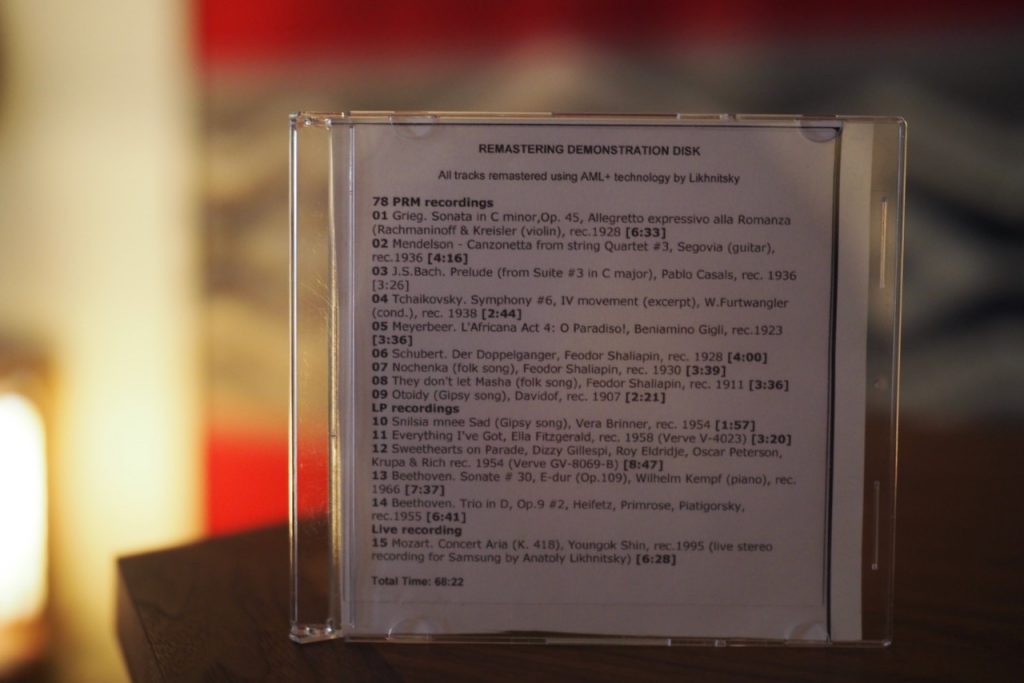
AML+ remasters of 78s from Peter Qvortrup
As another listening exercise I wanted to explore was the AML+ remasters of 78s that Peter Qvortrup sent me to listen to.
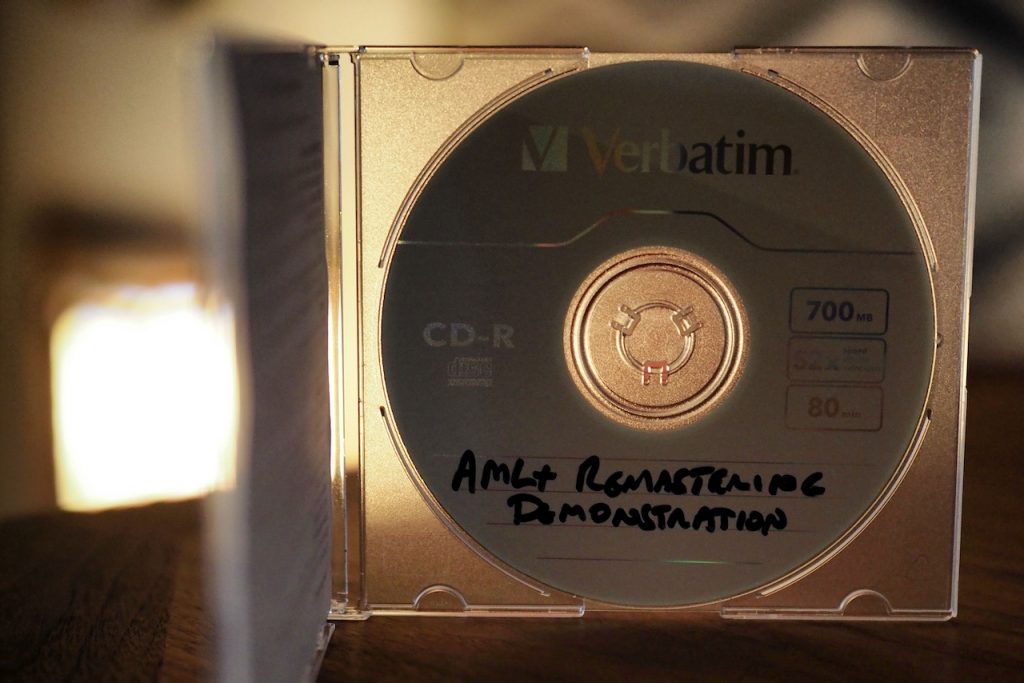
AML+ remasters of 78s from Peter Qvortrup
These are extraordinary performances of music that I really love to listen to. They sound remarkably good tonally, in terms of timbre, in terms of melody, and all those musical traits that I cherish hearing in recordings.
These transfers come from 78s, so you do hear more noise and anomalies in the recordings than you would in a well recorded album from the magnetic era of recording, for example, but there's a vivid presence, a live-likeness, a correct tonality, and level of emotional engagement these recordings offer that is unparalleled.
Any piece of audio gear that couldn't present these recordings as the wonderful documents of musical performances that they are, I wouldn't want to have that audio gear in my audio system.
The Emission Labs 45 mesh plates and Sophia Electric Aqua 274B rectifier combination sounded quite nice on these AML+ transfers, but I noticed that there was occasional harshness on dynamic peaks, just as there was some harshness with Desmond's alto sax.
When I substituted in the Sophia Electric 45 mesh plates for the Emission Labs 45 mesh plates, I immediately noticed the Sophia's extra resolution and transparency. That occasional harshness I was hearing disappeared. That extra resolution and transparency did accentuate the surface noise of the 78s somewhat, but also provided a more lively and engaging overall presentation of the music.
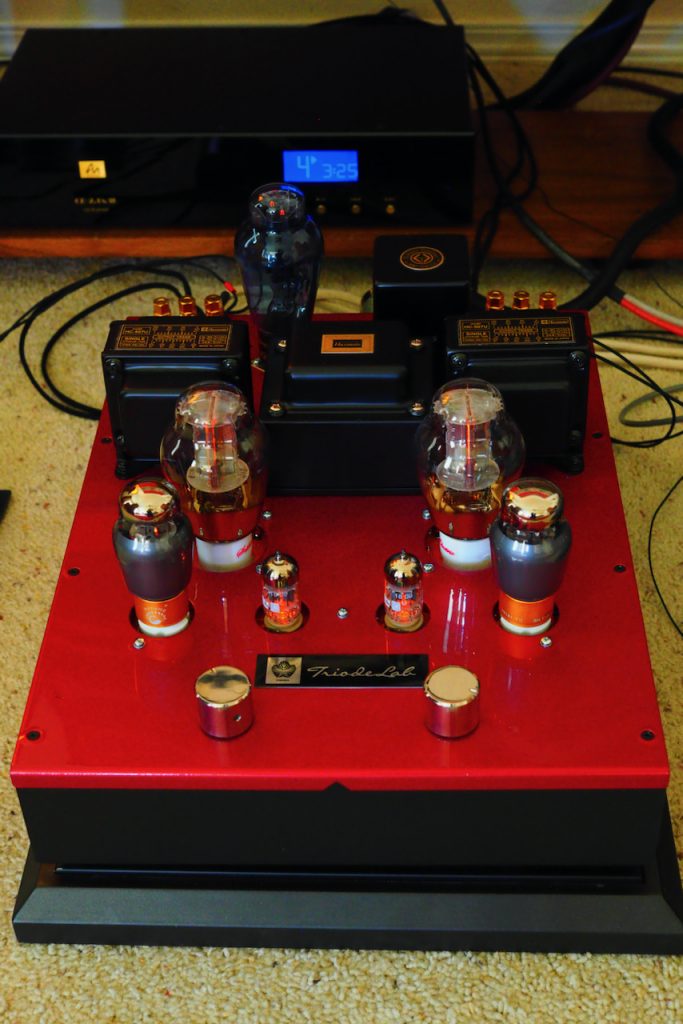
Triode Lab 45 EVO with Sophia Electric 45 mesh plates and the Sophia Electric Aqua 274B rectifier.
Ok, to wrap up, let me summarize what I'm hearing from these two sets of 45 mesh plates and 274B rectifiers.
Overall, I thought both of these tube sets were nicely musical in their own way, with presentations of timbre, tone color, melody, beat, and rhythm, that were different, but equally in a believable range of live-likeness, and enjoyable.
I found the Sophia Electric 45 mesh plates and the Sophia Electric Aqua 274B rectifier combination to be more resolving, transparent, nuanced, and more vivid, putting the musicians more in the room with me, while the Emission Labs 45 mesh plates and the Psvane Acme 274B rectifier combination were darker, richer, less resolving and vivid, and a little more distant sounding. Both provided compelling presentations of the music.
However, I found that Emission Labs 45 mesh plates and the Psvane Acme 274B rectifier combination got a bit harsh and aggressive sounding at unexpected times, as with the Paul Desmond alto sax example, or with some female vocals, where the Sophia Electric 45 mesh plates and Sophia Electric Aqua 274B did not.
I found this aspect of Emission Labs 45 mesh plates and the Psvane Acme 274B rectifier combination to be puzzling, as typically something that is darker, richer, and more relaxed sounding, generally would tend to also reduce any harshness and aggressiveness, but that was not always the case with this combination of vacuum tubes.
I should mention that when I was doing these same sorts of comparisons on my vintage Altec A5 Voice of the Theatre loudspeakers, or my vintage "Stokowski" Altecs, I didn't really notice that occasional aggressiveness from the Emission Labs 45 mesh plates and the Psvane Acme 274B rectifier combination.
However, it was obvious with my Westminster loudspeakers, and could be a bit unpleasant at times. The vintage Altecs are a little soft high-frequency wise, so that may have helped smooth things out a little with the Emission Labs 45 mesh plates and the Psvane Acme 274B rectifier combination.
Both the Sophia Electric Aqua 274B rectifier and the Psvane Acme 274B rectifier were in a different league performance-wise from other NOS rectifiers I tried in the 45 EVO. The 45 EVO is very sensitive to rectifier choice, and using anything other than these high-quality 274B rectifiers sounded dreadful in comparison.
I have a long history with the Sophia Electric Aqua 274B rectifiers in my vintage McIntosh MC30 monaural amplifiers, and now listening to the Sophia Electric Aqua 274B rectifier in the Triode Lab 45 EVO it affirms their place as the best sounding 274B rectifiers in my experience.
It's been a long time since I've owned a 45 SET amp, the custom Wavelength Audio 45 monaural amplifiers that Gordon Rankin made for me. In those amplifiers I only listened with a variety of NOS 45 tubes, and I have to say between the Emission Labs 45 mesh plates and the Sophia Electric 45 mesh plates, the Sophias sound more like the NOS 45s I listened to. The Emission Labs 45 mesh plates had a little more of the tonal character that I normally associate with 300B vacuum tubes.
In closing, let me repeat what Richard Wugang said in his overview of the history of the 45 tube (HERE):
"For the very modest power output, the 45 would have been forgotten. However, one outstanding strength has made audiophiles rediscover it decades later. The sound from 45 tube is simply pure, seductive, and even magical! Anything good that can be said about 300B tube, well, the 45 can do better, with only one limitation of 2W output, versus 3.5-4W from 2A3, and 8W from a single-ended 300B.
"If you have speakers efficient enough to utilize 2W of power output, then you can forget about any other fancy tube. However, 99% of us can’t, and thus the 300B still rules the land of tube audio with 4x more power and dynamic headroom than a smaller 45 tube."
The Sophia Electric Aqua 274B rectifier sells for $170 USD, and the Psvane Acme 274B rectifier for about $300 USD. The Sophia Electric 45 mesh plates sell for $400 USD per matched pair, and the Emission Labs 45 mesh plates sell for $600 USD per matched pair.
Ok, that's all for now. I'll continue to listen to these two sets of 45 mesh plates and 274B tubes to see if I can gain any additional insights into their performance.
A big thank-you to Richard and Sue for providing a pair of their Sophia Electric 45 mesh plate tubes and an Aqua 274B rectifier for me to try in the Triode Lab 45 EVO SET integrated amplifier.
As always, thanks for stopping by, and may the tone be with you!





























